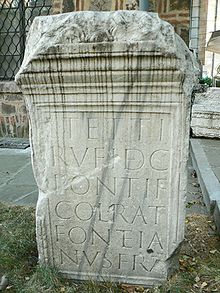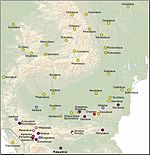- Ratiaria
-
Coordinates: 43°48′56″N 22°54′55″E / 43.81556°N 22.91528°E
 A grave stone with the inscription about Tettius Rufus, a Decurion and Pontiff of the Roman colony Ratiaria[1].; currently kept at the National Archaeological Institute and Museum, Sofia. The Latin inscription reads: D (is) M (Anibus) / L (uci) Tetti / Rufi dec (urionis) / Pontif (ICIS) / col (onia) Council (Iaria) / Fonteia / nus frat (s)
A grave stone with the inscription about Tettius Rufus, a Decurion and Pontiff of the Roman colony Ratiaria[1].; currently kept at the National Archaeological Institute and Museum, Sofia. The Latin inscription reads: D (is) M (Anibus) / L (uci) Tetti / Rufi dec (urionis) / Pontif (ICIS) / col (onia) Council (Iaria) / Fonteia / nus frat (s)
Ratiaria (or: Raetiaria, Retiaria, Reciaria, Razaria; Bulgarian: Рациария; Greek: Ραζαρία μητρόπολις; later named Colonia Ulpia Traiana Ratiaria) was a city founded by Moesi, a Daco-Thracian tribe, in 4th century BC, along the river Danube. The city had a gold mine in the vicinity, which was exploited by the Thracians.
It is located 2 km west of present village Archar in Vidin Province, northwestern Bulgaria. The closest modern cities are Vidin (27 km. to the north west) and Lom (28 km. to the east).
Contents
History
Ratiaria was conquered by the Dacians of Burebista and later by Romans.
The earliest involvement of the Romans occurred in 75 BC, when Gaius Curio Scribonius Burbuleio, prefect of Macedonia, entered this territory to ward off Scordisci, the Dardani and Daci.
Only during the principate of Augustus, the Romans conquered the region, which was organized in the province of Moesia. In 33/34 AD a road is linked between Viminacium and Ratiaria. The city was certainly less important than the near Sirmium, Viminacium and Naissus, but its location along the Danube limes made it a key point to station a legion. Legio IV Flavia Felix was based here at least until the conquest of Dacia (101-106 AD), together with the military fleet of Classis Moesica (during Vespasian).
After the conquest of Dacia, the castrum was abandoned and became a colonia within Moesia Superior under the name Colonia Ulpia Traiana Ratiaria (107 AD), named after its founder, Emperor Trajan.
With the definitive abandonment of Dacia Traiana by Aurelian in 271, the old castra were reopened and was utilized as part of the Dacia Aureliana and later the Eastern Roman Empire.
It is unclear whether Aurelian or the Emperor Diocletian replaced Dacia Aureliana with two provinces[2], but by 285, there were two: – Dacia Mediterranea with its capital at Serdica and Dacia Ripensis, with its capital at Ratiaria. Later these two “Dacias” along with Dardania, Moesia Inferior, and Praevalitana constituted the Diocese of Dacia.
As the capital of Dacia Ripensis, Ratiaria served both as the seat of the military governor (or dux) and as the military base for the Roman legion XIII Gemina.
A number of Roman patricians (aristocrats) lived in Ratiaria, while the nearby Bononia (today's Vidin) had established a small military unit.
Famous individuals
- Palladius of Ratiaria, late 4th century Arian Christian theologian
See also
References
- ^ AE 1911, 214; AE 1919, 81.
- ^ Bury, p. 135. The date must be A.D. 283, and it is obvious that Aurelian set up the boundary stones, one of which Gaianus restored. There were, then, two Dacias when Diocletian came to the throne and, therefore, Mr. Fillow has inferred that we should read in our List: Dacia <Dacia>, that is presumably Dacia Ripensis and Dacia Mediterranea. Aurelian's Dacia mediterranea might have included Dardania, and Dardania, Mr. Fillow thinks, was split off as a distinct province by Diocletian.
External links
- Bulgarian Archaeological Association - Excavations at Ratiaria
- Archaeological excavations of Ratiaria by the village of Archar
- Sarcophagus Ratiaria (Image)
Ancient Dacian cities and/or fortresses Acidava • Acmonia • Aedava • Aiadava • Aizis • Amutria • Apulon • Arcina • Arcobadara • Argedava • Argidava (Arcidava) • Arutela • Berzobis • Bregedava • Brucla • Buricodava • Buridava • Buteridava • Capidava • Carsidava • Clepidava • Cumidava • Danedevae • Dausdava • Desudaba • Diacum • Dierna • Dinogetia • Docidava • Drobeta • Egeta • Gatae • Genucla • Germisara • Gildava • Giridava • Itadava • Keiladeva • Klepidaua • Kuimedaba • Malva (Romula) • Marcodava • Murideva • Napoca • Nentidava • Oescus • Patridava • Patruissa • Pelendava • Perburidava • Petrodava • Pinon • Piroboridava • Polondava • Potaissa • Pulpudeva • Quemedava • Ramidava • Ratiaria • Recidava • Romboses • Rusidava • Sacidava • Sagadava • Sandava • Sangidaua • Sarmizegetusa Regia • Scaidava • Setidava • Singidava • Sucidava • Sucidava, Moesia • Susudava • Sykidaba • Tamasidava • Tapae • Thermidava • Tibiscum • Tirista • Tsierna • Tyrida • Ulpia Traiana Sarmizegetusa • Utidava • Zaldapa • Zargidava • Zeugma • Zicideva • Zimnicea • Ziridava • Zisnudeva • Zucidaua • Zurobara • Zusidava
Cities/fortresses with unknown names: Ardan • Ardeu • Arpașu de Sus • Breaza • Bretea Mureșană • Băile Tușnad • Bănița • Bâzdâna • Cernat • Cetățeni • Cotnari • Covasna • Crăsanii de Jos • Crizbav • Cuciulata • Cugir • Cârlomănești • Căpâlna • Drajna de Sus • Jigodin • Mala Kopania • Marca • Merești • Moșna • Odorheiu Secuiesc • Olteni • Orăștie Mountains • Polovragi • Porumbenii Mari • Praid • Racu • Satu Mare (Harghita) • Sprâncenata • Stâncești • Sânzieni • Șeica Mică • Tășad • Teliu • Tilișca • Timișu de Jos • Turia • Valea Seacă • Zemplín Dacia Maps on Commons • Dacian fortresses, settlements and Roman castra from Romania: Google Maps • Google EarthCategories:
Dacia Maps on Commons • Dacian fortresses, settlements and Roman castra from Romania: Google Maps • Google EarthCategories:- Dacian towns
- Roman towns and cities in Bulgaria
- Former populated places in Bulgaria
- Vidin Province
Wikimedia Foundation. 2010.

